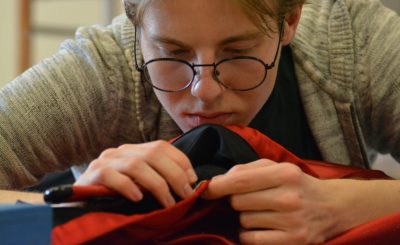Entrepreneur Allan Affeldt noticed one “tiny” flaw during last spring’s United World College-USA recycled clothing fashion show.
The venue was too small.
So immediately after the show closed at The Spot community center in Las Vegas, Affeldt offered the 3,200-square-foot ballroom at his nearby Plaza Hotel for the international high school’s Renaître Sustainable Fashion Show, which was set for April 11. It was canceled after students were sent home in mid-March because of the spread of COVID-19 in the United States..
“I loved the (2019) show, and I thought it was deeply insightful as so many things are at UWC,” said Affeldt, who has spent millions restoring historic and abandoned hotels, including the Plaza Hotel and Castaneda, also in Las Vegas; La Posada in Winslow, Ariz.; and The Legal Tender Saloon in Lamy.
Affeldt’s offer stunned Jagoda Sokolowska, a UWC-USA student from Poland, who for a second year led the Montezuma school’s sustainable fashion show.
“I was so incredibly surprised,” said Jagoda, who has been accepted to Parsons Paris, a leader in art and design education. “It made me feel so humbly proud of myself after all this effort. It was definitely an incredible moment.”
For this year’s show, students planned to model redesigned fashions ranging from casual to very formal. The 10 student designers’ fashions were to be sold during a live auction at the close of the show. Donations were to go to Fashion Revolution, a global non-profit in campaigning for reform of the fashion industry with a focus on the need for greater transparency in the fashion supply chain.
Students also suggested that Jagoda sell her fashions from last year and sketches to help pay for her college.
“I really was surprised because I was thinking about how much money I need for college,” she said.
Jagoda planned to donate 30 percent of the money from her sales to Fashion Revolution and save the rest for college.
Jagoda explained that Renaître is a fashion show that aims to express the importance and genuine beauty of sustainability, which is also part of the mission for UWC’s 18 schools around the world.
“All garments have been handmade from donated discarded clothing used as a fabric to give them a magnificent new life,” she said. “The collections of reborn attire have been entirely created by the students of UWC-USA.”
Designers also have been incorporating aspects from their own cultures into the lines.
UWC-USA art teacher Santos Contreras expected good things from this year’s show after last year’s event.
“Jagoda is really building upon that success,” Contreras said prior to the show’s cancelation. “She’s obviously very talented and has an ability to teach others to think about fashion and how to work with materials.”
Last year, students focused more on altering donated clothing, he said. This year students are taking apart and reusing the clothing.
“You can see the personality of individuals in the clothing,” Contreras said.
Student Vidar Onnerfors, Sweden, had never used a sewing machine prior to this fall, only a needle and thread to make a small pillow at age 8. Vidar’s interest in clothing and fashion prompted him to get involved with the show.
“I thought this was a useful opportunity to learn more about it and also to be able to design my own clothing,” he said. “I also found it interesting that we would only be using repurposed clothing and that sustainability was one of the center focuses. I think that in an industry which is generally highly unsustainable — at least when it comes to fast fashion brands — it is important to shift the focus away from such practices and understand how clothes can be made through recycling materials instead.”
Vidar made a fleece with a coffee cup design on the back and a pair of neon green pants.
Students started working on designs in September; only two had ever used a sewing machine prior to taking on the project.
“It’s really wonderful to see how people have developed,” Jagoda said.
As for her own interest, Jagoda said as far back as she can remember, she has had a passion for fashion. She credits her grandmother, who passed at age 64 when Jagoda was only 6.
“She was incredibly close to me and she always looked so elegant,” the 18-year-old said. “I wanted to follow her activities and steps. She was also an incredibly strong person — a judge who advocated for women oppressed by the Communist government.”
At age 13, Jagoda’s dream of creating clothing came closer after she found her grandmother’s sewing machine on Christmas Eve. Jagoda took advantage of her two-week winter break to learn to use it.
“At the beginning I was sewing pillows and little toys, and over the summer, very simple clothing,” she said.
Three summers ago, Jagoda met a fashion designer who invited her to do a two-week internship at her shop.
“It was incredible, like a family feeling,” she said. “It was the first time I experienced more of this profession.”
Jagoda’s followup introduction to renowned Polish fashion designer Natasha Pavluchenko turned into a month-long internship.
“It was the best fashion learning experience,” Jagoda said. “She was teaching me how to create a collection from the beginning — from sketching, developing ideas and sewing the clothing.”
Jagoda continued creating clothing with sustainability in mind.
“I was creating from new fabrics, old curtains, scraps. I wanted to convey what I wanted to express,” she said.

